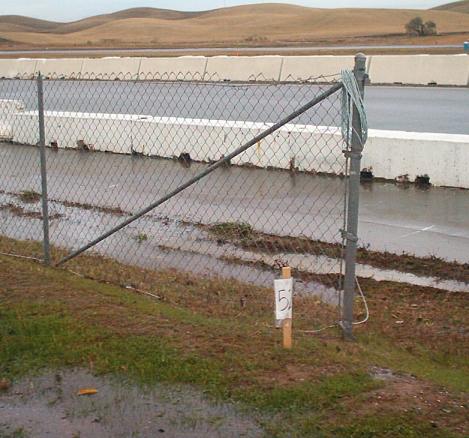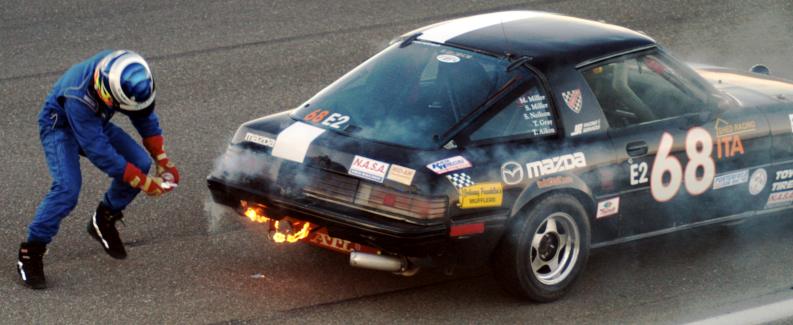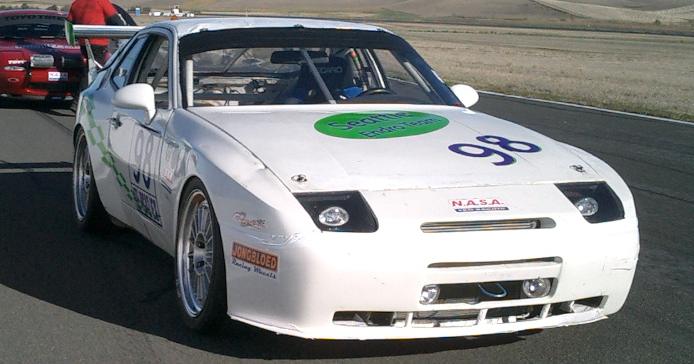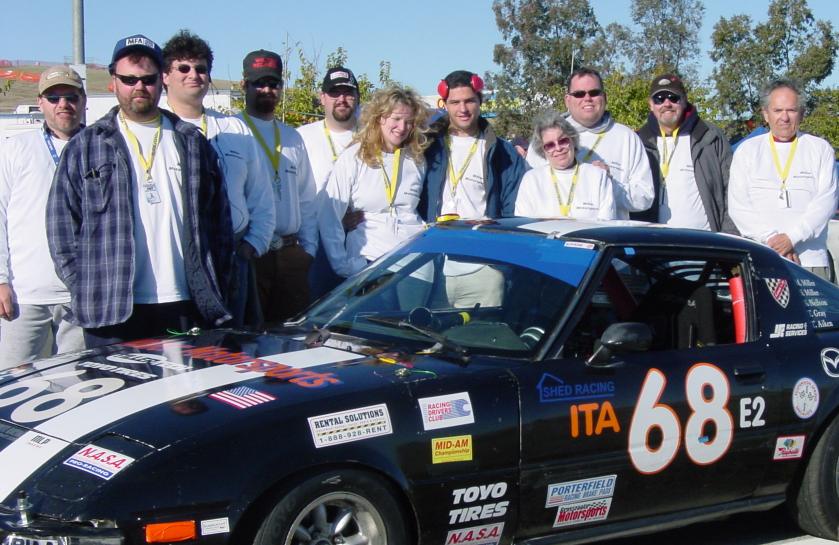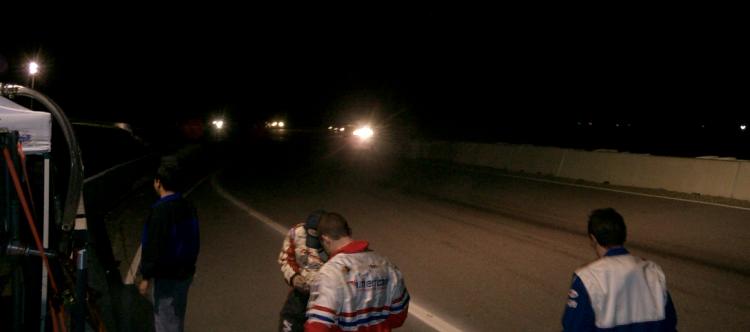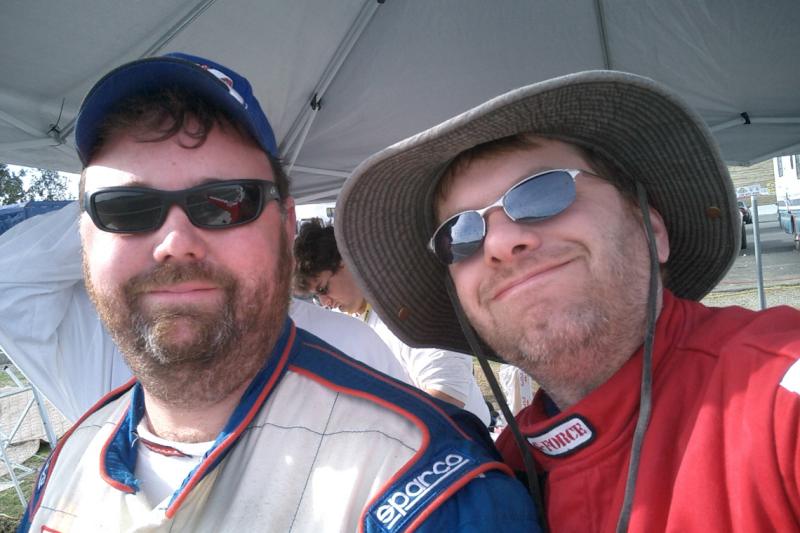NASA's
25 hours of Thunderhill.
Shed Racing joins Miller Motorsports
For the world's longest endurance race
By: Tom Aiken
Marcus Miller and Scott Lipton were the designated Sooners for the
event, leaving for Thunderhill early on Thursday, and were the 5th team
in line when the gates opened. They were able to secure an
excellent area in the paddock, with electrical power, only a couple
hundred feet from our space in the hot pits, and relatively close to a
semi-improved bathroom. They got approval from NASA for the spot,
then unloaded the ITA car (AKA the 25 hour car), and relaxed for the
rest of the morning.
Around lunch time, they decided the weather was nice, so they should
start to get set up, so they left the warm dry administration building
for the 2 minute drive down to the paddock area, and by the time they
got there, the wind had picked up and the rain started. They
managed to set up one canopy and huddled under it for shelter from the
storm. I arrived at the track an hour later, followed by Tim
Gray with his RV, and John and Sean Neilson with their enclosed
trailer. The trailer and RV were set up in an "L" shape to block
as much wind as possible, and canopies were set up to make a 20' X 20'
garage and kitchen area.
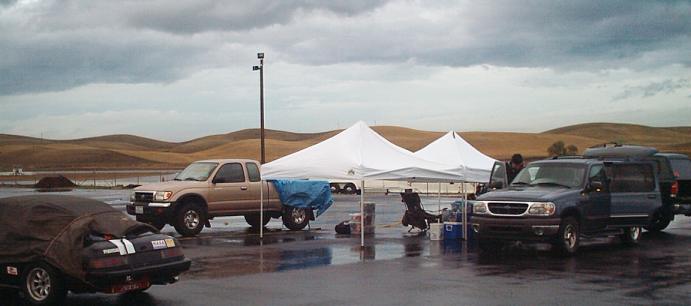 Setting up in the rain.
Setting up in the rain.
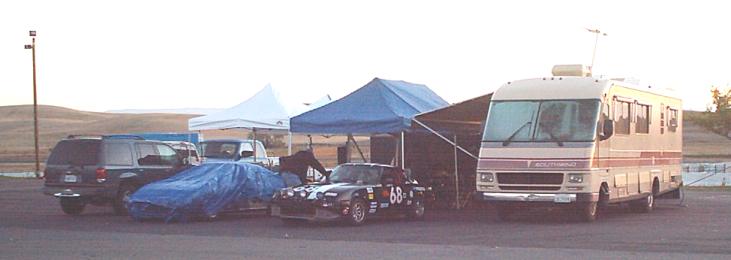
Finished Paddock area
Morning broke with good weather for the Friday test day, clear and
chilly. The rain had ended late Thursday afternoon, and although
we did have a bit of a swamp in the back of their assigned pit box to
deal with, in general things
were starting to dry out. Scott Miller showed up around 9 AM,
towing the spare Pro-7 car behind his Lincoln. The extra
car was there to rob parts off if we needed to, and to get Sean and Tim
more time on track, as neither of them had driven Thunderhill
before. Crew members Grant Conley, Bryan Crall and Angie
Balcomb showed up after breakfast, as did Robert and Mary Miller.
Robert
Wils showed up later with another RV, for crew quarters.
The
team pit box
Things got off to a rough start, when Marcus went to start the race car
and discovered a dead battery. Once the car was started, a new
rear tire rub was discovered on the driver’s rear, as well as some
intermittent electrical
problems. While John and Marcus were sorting these problems out,
Tim and I took my truck and headed to town to get fuel for the test
day, and went by the lumber yard for some plywood and 4x4s to bridge
the pit-box marsh. We got back and built the pit bridge, while
Marcus and Sean took turns bedding brake pads and scrubbing tires for
the race, and getting Sean some time to learn the track.
During the morning testing, we also discovered the rear camber settings
are radically
different from side to side (zero v. -2º ), and the ride heights
were off. After the morning testing, the crew swapped the
front corners to bed in the second set of brake pads, and we mounted up
the rain tires on the Pro-7, which I took out to turn a few laps and
scrub in the rain tires.
The radios were barely adequate, and we never got a really accurate
assessment of
our fuel consumption, although we did manage to have a nice fuel fire,
which was successfully extinguished by driver Sean Neilson on the back
straight. It seems the fuel cell vent wasn’t in a really good place,
and some overflow was ignited by one of those pretty Mazda RX-7
backfires. The errant vent has been relocated, and a check valve
added.
Fire
Marshal Sean (thanks to Doug Macmillan for the photo)
The car was slower than it should have been. Marcus's best time
in the Pro-7 car is a 2:13.xx, and normally is in the 2:15 range.
The ITA car by class rules is allowed wider tires and better suspension
prep, but the best time we were able to get all day was a
2:18.xx. The car has the engine from the Pro-7, but with a better
exhaust setup which should give a nice horsepower improvement, but even
though it had better suspension, more power and more rubber, the times
were slower. For a grand finale, the transponder quit working, so
we were not able to post a
qualifying time.
Even though we weren't all that fast, we did keep the car pretty much
in one
piece, something that can’t be said for all of our competitors. A
944 driven by the "Seattle Endro" team rolled in practice. Nobody
was hurt, and the crew hammered the roof back into place, and
installed new
windshield. They had it ready to race with time to spare.
This
car rolled in practice. This is after the repairs.
Friday evening was spent doing last minute items, like installing the
video camera, and applying a couple dozen new stickers. We also
needed to remove the transponder from the Pro-7, and install it in the
ITA car. Everyone
knows, the more stickers you have on your car, the faster it
goes. We also applied tape strips to the rear window, to reduce
the brutal headlight glare from other cars.
Stickered
up and ready to race
Ron Swett arrived Saturday morning, with his driver's gear, ready to be
the gas-man for the whole race, and he and I made a last minute change
to the location of the pit marker light, moving it from the roll cage
inside the passenger door to the roof just in from the rain
gutter. We also added a yellow stripe to the roof above the
passenger side door, to make the car easier to identify in the
dark. Sean took the car down to verify the spare transponder was
working properly, which it was.
At about 10AM cars started to line up on the grid. Because of the
lack of a qualifying time due to the transponder failure, we were
gridded near the back of the pack.
On
the Grid (L-R) Ron Swett, Tom Aiken, Scott Lipton, Grant Conley,
Scott Miller, Angie Balcomb, Bryan Crall, Mary Miller, Marcus Miller, Bob Wils, Robert Miller
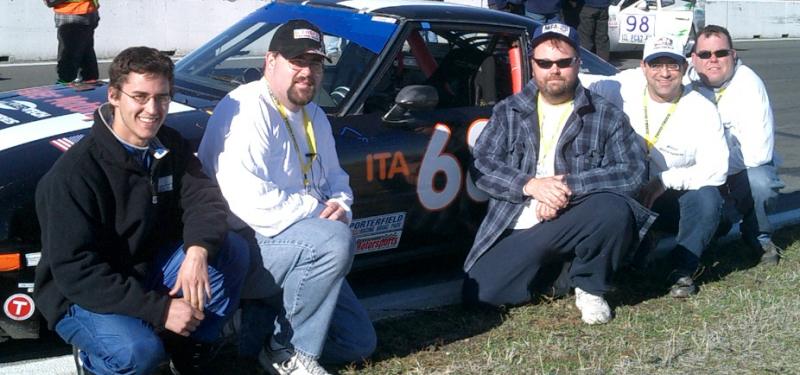 The Drivers: Sean Neilson , Scott
Miller, Tom Aiken, Tim Gray, Marcus Miller
The Drivers: Sean Neilson , Scott
Miller, Tom Aiken, Tim Gray, Marcus Miller
After the National Anthem, the PA system announced the words we had
been waiting for: "Drivers, Start your engines" It was
show time. Unfortunately the F-15 flyby by the Air Force was
delayed due to weather in Oregon, but they did come by about an hour
into the race.
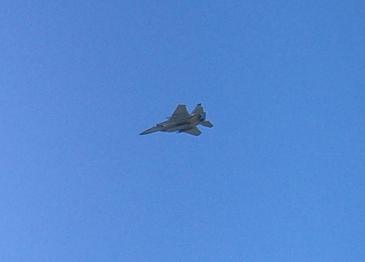 Air Force F-15 Eagle flyover
Air Force F-15 Eagle flyover
Sean Neilson drove the first stint, and he strapped in, and set out
with the rest of the field for the pace laps. The first lap, the
pace car brought the entire field down pit road, to demonstrate the pit
road speed limit. For us this turned out to be 4000RPM in Second
gear. The next time around the pace car came into Pit road, and
the green flag flew. The race was on.
Because we didn't get a good fuel consumption test, the
plan was to do this during Sean's stint. The car has a 15 gallon fuel
cell, but are only
allowed by the rules to put
in 10 gallons of fuel per stop. The idea is to make sure there is
less than 5 gallons in the tank for all pit stops, to preclude any
chance of overfilling the tank and causing a fuel spill. Any
significant fuel spill brings a five minute penalty, which we wanted to
avoid. The only active pickup in the fuel cell is
on the right side, and Thunderhill is mostly left turns, so the theory
was that we would have plenty of warning before the cell ran dry, when
it started to sputter on one of the few right turns, we would come in
for fuel and a driver change. It seems our theory
sucked, as the car
sputtered one time before the engine died from lack of fuel.
Sean
rolled the car on the escape road before turn 6 and waited for a tow
back to the pits. The car was in a safe spot, and race control
didn't want to bring out a full course yellow, with pace car to
retrieve our car, so we had to wait until there was a gap in the race
traffic to tow the car across the front straight. Unfortunately
this took about 10 minutes.
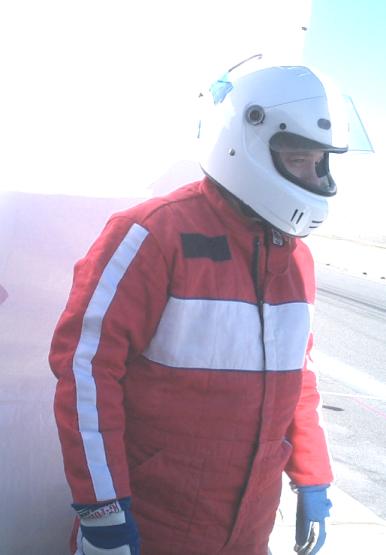 Ron Swett, ready to fuel the car
Ron Swett, ready to fuel the car
Tim Gray took over from Scott, and after about 20 minutes went off in
the turn 5 bypass. When he came back on, the low hanging panhard bar
(The panhard bar keeps the rear axle in the proper position) caught on
something, and broke. Sean, Scott and I were all experiencing
a bit of wheel hop under hard braking, which certainly didn't help
things, we think the bar was probably weakened a bit, and his off was
just the last straw.
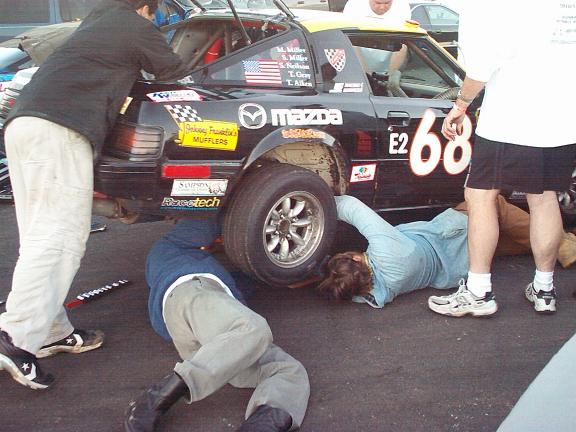 Robert Miller and Grant Conley work on
the rear suspension, while Bryan Crall inspects the shock towers
Robert Miller and Grant Conley work on
the rear suspension, while Bryan Crall inspects the shock towers
John Neilson, (Sean's dad) whipped out the welder and some scrap steel
and repaired the panhard bar, which was reinstalled, and Tim went back
out to finish his stint. I think we only lost 30 or 40 minutes.
Tim completed his first stint into the darkness without incident.
Marcus took over the car, and immediately had an electrical problem
that left 2 of the 4 headlights dark. The car is set up with two Dick
Cepek 130W off-road spotlights pointing forward, and two 100W PIAA
lights
angled to the sides to light the apexes. A flaky switch left the two
spots dark, leaving the apex lights the only illumination. A fuel
pickup problem also surfaced with the cell, causing the car to sputter
after burning only ~6 gallons of fuel, but the cause would be a mystery
for a few more hours. Marcus hit pit road complaining of missing, and
gas man Ron Swett threw in a can of fuel, after which Scott Miller
fixed the electrical problem bringing the primary lights back online.
Marcus went back out, and with the ability to see where he was going,
he was able to pick up the pace, setting the fastest lap so far, a
2:17.xx
Twenty minutes after returning to the track, one of the brand
new Mazda Factory Miatas caught up with Marcus in turn 2, and decided
that the best
way to get around was to with two wheels off in the dirt on the inside.
Marcus tried to adjust his line to keep the Miata out of his door, and
ended up agricultural way off to the outside of turn 2. I am certain if
it was daytime, we could have seen the cows running for their lives.
Unbelievably, Marcus didn’t get stuck, and managed to make it back to
the pits, but left a large portion of his front valance and brake ducts
out in the pasture with the cattle.
A quick inspection found most of the damage cosmetic, but the lower
skid plate was rather loose. Sean took over the car, and went out, but
we had to call him in a few laps later when the corner workers reported
sparks from under the car. It turns out the skid plate was looser than
was initially thought, and was dragging on the track under the car and
kicking up sparks as it was being ground away by the tarmac. Hasty
removal of the offending part put Sean back on the track with minimal
delay.
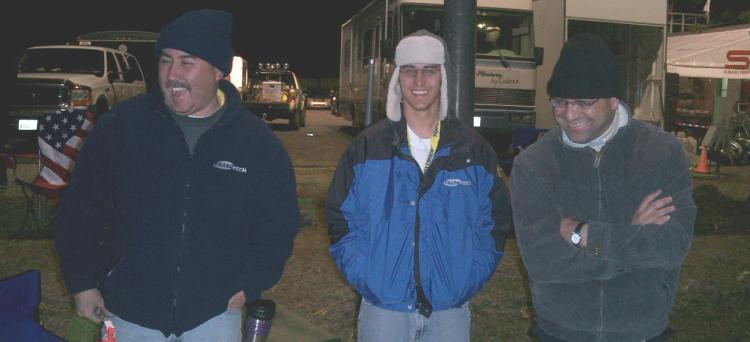 John Neilson, Sean Neilson, and Tim
Gray
John Neilson, Sean Neilson, and Tim
Gray
Thirty minutes into his session, Sean pitted with sputtering. An
initial assessment that the vent check valve was sticking allowing the
cell to pressurize was proved wrong, when the check valve was removed
and Sean went back out on track, the engine still sputtered in some
corners. Ron added 5 gallons of fuel, and sent Sean back out on track,
while the crew conferred on the likely cause of the fuel problem. A
decision was made to swap to the other pickup from the cell to see if
it helped. After another 30 minutes to finish his stint, Sean came in
and Ron swapped the fuel cell fittings and refueled the car. And I got
back in the seat for my first night session. Swapping the pickup points
fixed the fuel starvation problem, as my stint was uneventful, and I
ground out laps for about 80 minutes without incident. Scott Miller got
back in the car for his second stint, and returned to the pit lane some
10 minutes later with his right front fender pushed in and rubbing the
tire from mild body contact with a Camaro. Some quick tugging on the
fender fixed the rub, and Scott went back out, and finished his stint
without any incident and handed the car over to Tim.
Tim’s second stint was clean, as was that of Marcus, who went out after
him. At the end of his second stint, the race was past halfway, so
Marcus brought the car behind the wall for scheduled mid-race
maintenance. 25 minutes later, Sean reentered the track with fresh
front brakes. Some time during the night,
one of the Dick Cepek offroad lights quit working, but the other was
working
well enough that it wasn’t a problem. Yet.
Sean had another clean run, and after 70 minutes, he came in and I got
back in the car. When I fired the car up after the fuel stop, the
remaining Dick Cepek off-road spotlight failed, leaving me to run my
whole 70 minutes with only the PIAA apex lights. I had another clean
run, followed by still more poorly lit but clean sessions by Scott and
Tim, who drove the car into the first light of day.
We had survived the night, but others were not as lucky.
Professional ALMS and 24 hours of Le Mans driver Johannes van Overbeek
lost a tire on the back straight and flipped his Porsche 911, totaling
the car. A Factory Five Cobra
replica driven by Spencer Sharp was having mechanical problems
and made a surprise left turn for an access road, directly in
front of 2007 Mazda Miata driver Johnny
Kanavas resulting in a spectacular double flip off of turn five in the
early dawn of Sunday morning. The 2006 Mazda Miata
was a total loss as was the Factory Five racer. Johnny
Kanavas suffered a broken thumb in the crash, but thankfully there were
no other injuries..
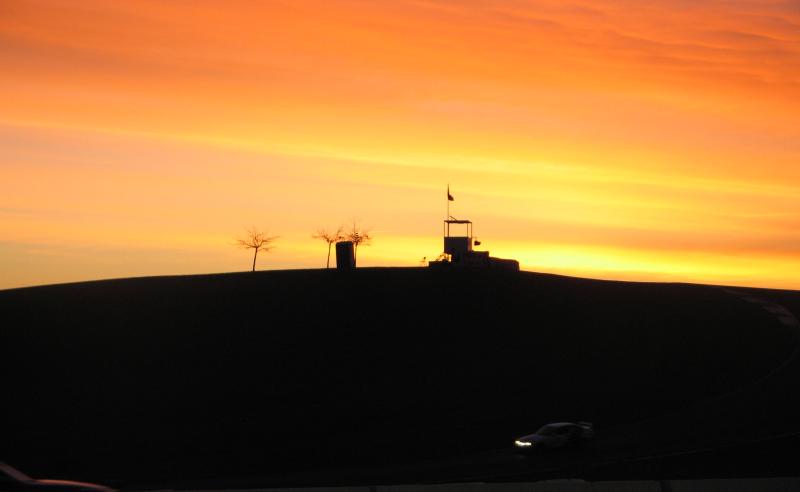 Sunrise Sunday morning
Sunrise Sunday morning
Marcus resumed the controls, and near the end of his stint, the Panhard
rod broke yet again,
sending the car behind the wall again for some therapy with the welder.
After a short delay, we got going again, with Sean back in the car,
starting the 4th and final rotation through the driver lineup. The
standard 70
minute stint schedule was dropped at this point, as our position in the
finishing order was unlikely to change, as there were 12-15 laps
between the cars ahead of and behind us. The schedule was adjusted, to
allow one more complete pass through the rotation, allowing car owner
and team principal Marcus Miller to finish the race.
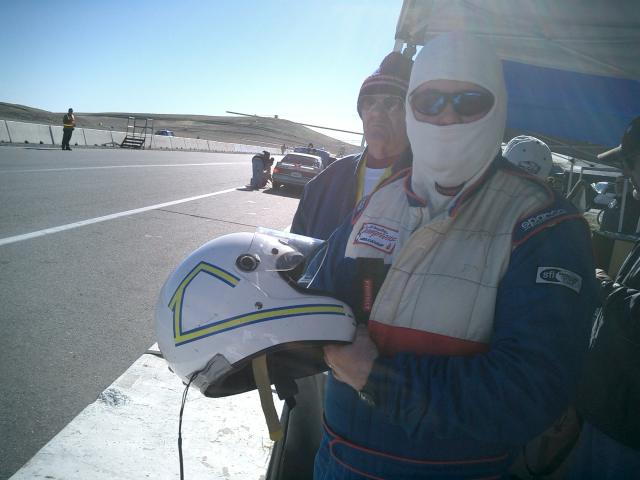 Tom Suited up for his final stint
Tom Suited up for his final stint
As Sean’s stint was drawing to a close, I was suited up ready to get in
the car for my last session, I made my normal last chance bathroom
break about 5 minutes before Sean’s scheduled pit window, only to
return and find him on pit lane with what seemed to be another fuel
pickup problem. It seems he hit pit road as soon as I left the pit box.
Luckily Scott Miller was in the pit box, in his driving gear so all he
had to do was pull on his helmet and hop in the car and go. I came back
to the pit box as he was getting in the car. Sean reported that during
his stint, the clutch had started slipping after 3rd to 4th gear
shifts.
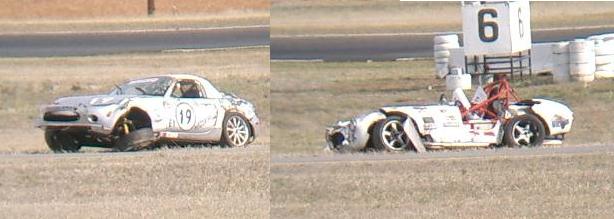 Wrecked Miata and Cobra
Wrecked Miata and Cobra
Tim’s final stint was essentially the same as mine, but he did
determine the grinding noise from the rear was probably coming from the
limited slip, as it only seemed to do it if you were trail braking. As
long as
you braked in a straight line, it was quiet. Tim left the car running
for the final driver change, as Marcus got in the car for the final 20
minute limp to the checkered flag. We didn't fuel, so we left the car
running for the final stop. Video of
the last stop (3MB WMV file)
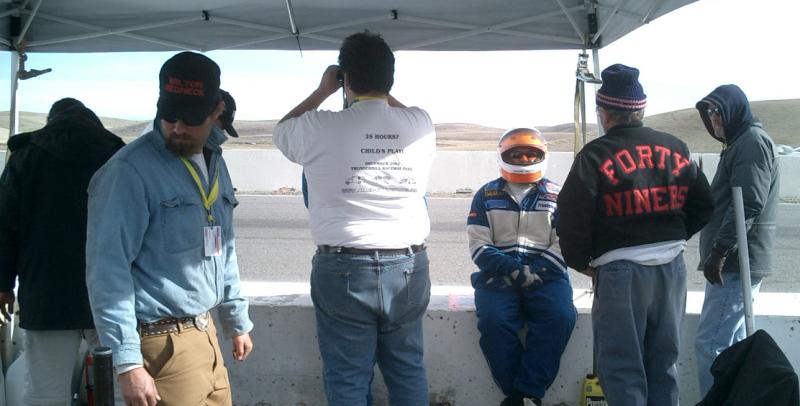 Marcus waits for the last driver change
Marcus waits for the last driver change
As the time ticked closer to zero, the crew nervously waited in the
pits when Ron pointed out that every time Marcus drove by, the car was
a little louder. An ugly exhaust leak had developed, and with about 10
minutes left in the race, the exhaust pipe broke in 2 pieces just
behind the header, and the resonator and pipe were hanging under the
car, nearly dragging on the track.
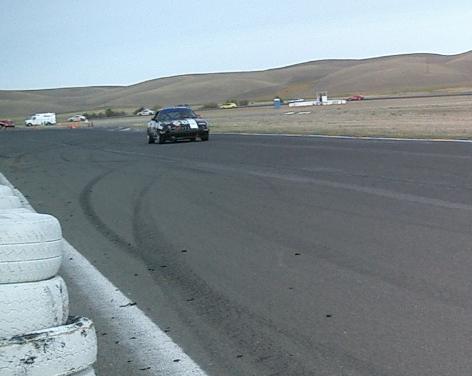 Marcus heads for the checkered flag
Marcus heads for the checkered flag
Marcus held out to take the checkered flag, finishing the longest
closed course endurance race in the world. We finished 34th overall
13th in class, and completed 511 laps, or 1533 miles. Of the 58
teams that
started the race, only 45 were running at the finish, and some of the
finishers had been parked for hours, just waiting to limp across the
finish line at the end, so they could finish. Our class had 20
teams.
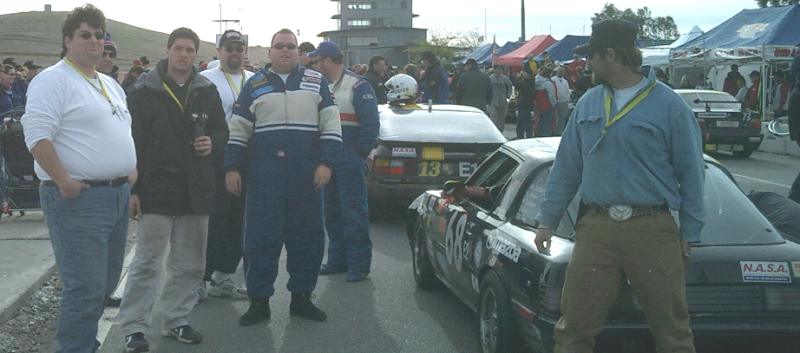 Post race impound on pit road
Post race impound on pit road
It was a blast.
Congratulations to the Lost 'N Spaced Racing Porsche 911, who took the
overall win. The second place car was the SSF BMW M3, followed by
the Car and Driver Subaru.
Congratulations also to Team German Sport / Mel & Sons Muffler /
Workpad.com who consisted of GTI Cup regulars Carlos
Suarez, Don Bailey,
and Dan
Piña who won the E3 class, and finished an outstanding 18th
overall in their VW rabbit GTI. Norcal GTI racers David
Piña and Scott
Neville were there as crew. You can read their race diary here.
Thanks to everyone who made this possible. Marcus and Scott for
the Vision, Scott Lipton for organization and administrivia, Ron for
keeping the car fueled without spilling a drop and keeping the timing
straight, Grant, Bryan, Robert, Charles and Bob for keeping the fuel
jugs filled, and wrenching on the car and everything else, Fire Marshal
Sean for saving our weekend, Tim for bringing the outstanding brake
parts and the warm place to sleep in the RV, John for welding the car
back together twice and generally keeping it alive, Mary and Angie for
keeping us in food and coffee
We are looking forward to next year.
Full results are available from NASA here.
The official NASA Press Release is here
Video
of the last stop (3MB WMV file)
Photo
Gallery
Csaba Csesre, the Editor in Chief of Car
and Driver was part of the team in the next pit box. They
have articles, video and photos here:
http://www.caranddriver.com/article.asp?section_id=4&article_id=10379
The videos of their pit stops were taken from our pit wall.
Some strats pulled from Timing and Scoring:
Marcus had the best lap of the race, with a 2:16.6 in lap 152.
Sean's best was a 2:17.1 in his first stint, but did four 2:17.xs and
a string of :18 and :19s in his last stint, when the car was
pretty
much used up. Of the 28 laps in his final stint, all but 4 were
2:20.x or below. Outstanding consistency with a tired car.
Scott turned a 2:18.7, in lap 235 just past the 11 hour mark.
Tim's best was a 2:18.9, turned in lap 261, just before midnight.
My best was a 2:19.9, done in my first stint. In daytime.
My best lap in the dark was a dismal 2:24. Unlike Scott and Tim, I
get slower when I can't see ;-)
The panhard bar repairs cost us about 30 minutes each.
Marcus's visit to the back pasture cost us just over 10 minutes,
closer to 12 counting the second stop to remove the skid plate.
The midpoint stop to change the brakes was just under 30 minutes.
Fuel stops/driver changes added 4-6 minutes per stop.
I was about 5 seconds per lap slower in my second night stint, after
the driving lights failed. It didn't seem to bother Scott as much
as
it did me.
The transmission crossmember bolt falling out cost us just over 20
minutes.




